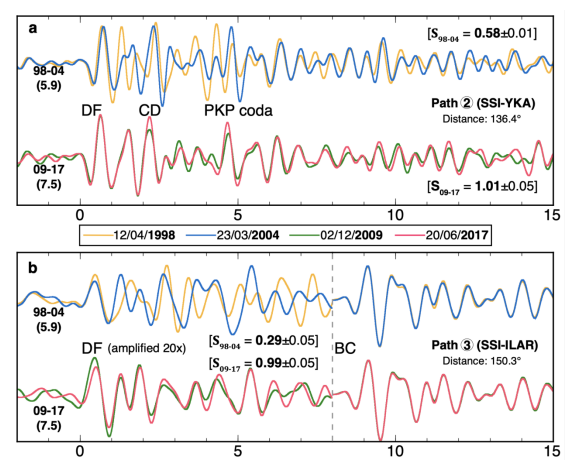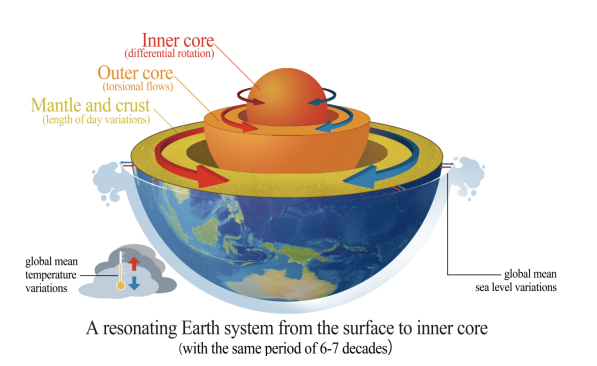Chinese Scientists Found Rotation of the Inner Core Changes over Decades
The Earth’s rotation is not exactly 24 hours per cycle, but slightly changes every day. What is more surprising is that the Earth’s inner core has a different rotation period from the outer Earth layers. The phenomenon, known as the inner-core rotation, was discovered in 1996. The Earth's core is made of iron alloy with some light elements, which is divided into two major layers: the liquid outer core and the solid inner core. The convection in the outer core generates the geomagnetic field, and the electromagnetic torque exerted on the inner core drives the inner-core rotation. Meanwhile, under the influence of gravity, the solid and heterogeneous inner core and mantle are coupled gravitationally, which affects the inner-core rotation. However, determination of the speed and mode of the inner-core rotation have been quite challenging in the geophysical community, from geodynamic simulations and seismological observations. Solving the problem will provide new constraints on the dynamical processes in the deep Earth dynamics and the core-mantle coupling mechanism, and will help us better understand the
inner working of the Earth.
Prof. Xiaodong Song at the School of Earth and Space Sciences (SESS), Peking University, and Dr. Yi Yang, an Associate Research Scientist in Song’s group, recently revealed the pattern changes of the Earth’s inner-core rotation over the past six decades. Their study traces the pattern of the Earth’s inner-core rotation using natural repeating earthquakes that occur at the same source location and with the same focal mechanism. Seismic waves from the repeating earthquakes usually have the same waveform at the same station, but when the waves interact with the Earth’s inner core, they show different waveforms and arrival times (e.g., Fig. 1), because the rotating inner core shifts its lateral heterogeneous structures, and the two earthquakes have the same raypath but sample different inner-core structures. By analyzing the pattern of the waveform changes, we can infer the mode of the inner-core rotation. Most surprisingly, the temporal change in seismic waves simultaneously disappeared along global paths in the last decade or so. More precise inversions using the travel-time temporal changes have shown that the inner-core rotation came to a halt in ~2009 and then a reverse. A similar reversed rotation was found in the early 1970s, implying a likely oscillating pattern with a period of six to seven decades. Such a multilectal oscillation (six to seven decades) also exists in several other important geophysical observations, in the geomagnetic dipole changes, the Earth’s length of day (LOD, i.e., rotation period) variations, and even the global mean sea level and temperature changes. The geomagnetic dipole changes imply the changes of outer-core fluid motions; the change of day length represents the change of angular velocity of mantle and crust rotation, and the change of global sea level and temperature originates from the change of surface and atmosphere. Thus, the result suggests a coupling and resonating system with a multidecadal period, from the inner core to the shallow surface. The dynamics of the whole earth system involves the inner core, outer core, mantle, crust, and surface of the Earth, with coupling effects across those layers, such as electromagnetic and gravitation coupling (Figure 2). The related papers were newly published on January 23, 2023 in Nature Geoscience. The research paper is entitled “Multidecadal variation of the Earth’s inner core rotation” and the research briefing is entitled “Rotation of the Earth’s inner core changes over decades and has come to near-halt” (see the links at the end of the report). Dr. Yi Yang is the first author of both papers, and Prof. Xiaodong Song is the corresponding author of the papers. This research is affiliated with the Sinoprobe Laboratory, which is jointly set up by Chinese Academy of Geological Sciences and Peking University. The research was supported by the National Key R&D Program of China on “Earth System and Global Change”, the National Natural Science Foundation of China, and China Postdoctoral Science Foundation. The School of Earth and Space Sciences (SESS) at Peking University offers 5 undergraduate majors (Geology, Geochemistry, Solid Geophysics, Space Science and Technology, and Geographic Information System). Earth and space sciences are not only a basic science, but also a science widely used in modern societies and economic development. The geology and geophysics programs of Peking University are the oldest among similar disciplines in China. The SESS is an important base for earth science research and talent training in China. It has played an important role in the scientific and economic developments in the country. The Deep Earth Science and Detection Technology Laboratory was established in 2020, based on the Chinese Academy of Geological Sciences. The main goal is to unite the research forces of relevant components in the country, organize and implement national deep earth research tasks, promote international cooperation, and build a national deep earth research platform. The laboratory focuses on the frontiers of deep structure, deep material, deep resource and deep processes, and builds platforms for deep earth data, detection technology and equipment, and experiment support. The laboratory is open to researchers in the world, through collaborations and recruitments, and cooperates with international organizations and research institutions and universities. The previous deep exploration project (SinoProbe-1, 2008-2014) has laid a solid foundation, built technical equipment and a talent team, and has generated good international response. Contacts: Authors: Prof. Xiaodong Song, xiao.d.song@gmail.com; Dr. Yi Yang, yiy@pku.edu.cn SinoProbe Laboratory: Prof. Shuwen Dong, swdong@cags.ac.cn Links: Research Article: Yang, Y. and X.D. Song, Multidecadal variation of the Earth’s inner core rotation, Nature Geosci, Jan. 24, 2023. https://www.nature.com/articles/s41561-022-01112-z Research Briefing: Yang, Y. and X.D. Song, Rotation of the Earth's inner core changes over decades and has come to near-halt, Nature Geosci, Jan 24, 2023. https://www.nature.com/articles/s41561-022-01113-y Figure 1. Example of time-varying inner-core seismic waves. There is significant change between 1998 and 2004 (a), but not change between 2009 and 2017 (b) in the inner-core phases (DF, CD, and PKP coda). The outer-core phase (BC) always remains unchanged.
Fig 2. A possible resonating Earth system from the surface to the inner core. The system includes the inner core (from its differential rotation), the outer core (from the magnetic field changes), mantle and crust (from the LOD variations), and the surface (from the global mean sea level rise and temperature).



